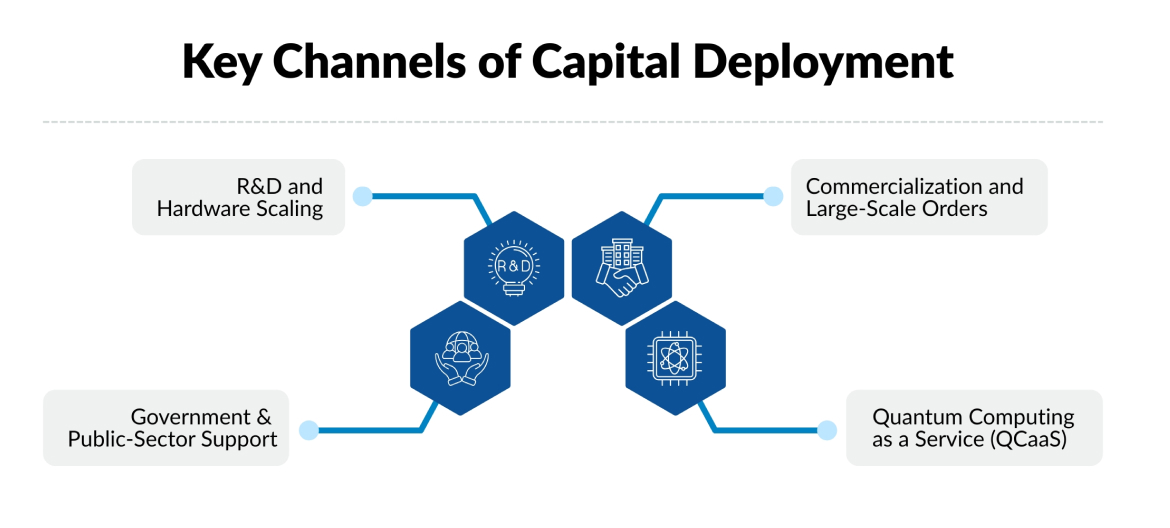Introduction
The quantum computing funding momentum is at a new peak, indicating that niche experimentation has already become mainstream investment in its focus. Venture capital firms no longer think about quantum as a far-off bet but as an important frontier that will define industries in the future. In the case of quantum startups, this influx is both validation and pressure: it is a sign that their ideas are receiving serious investment, and a challenge to demonstrate practical uses that can justify the unprecedented onslaught of investment.
The Surge in Venture Capital Flowing into Quantum
The recent spike in quantum computing venture funding is an indicator of a rise among investors that quantum startups are no longer theoretical and that they are having practical effects. In 2024, venture capital invested an estimated USD 1.9 billion in quantum startups in 62 funding rounds, a blistering 138 percent increase over the USD 789 million raised in 2023, according to Crunchbase data. This spike indicates the speed with which investor mood changed, between subdued enthusiasm and assured capital outlay.
More granularly, investment activity in Q1 2025 also highlights this momentum. During that time, quantum ventures raised USD 677.2 million, compared with USD 426.1 million in Q1 2024. It is important to note that European startups took 47.5 percent of that total, a rise of 16.5 percent from the previous year.
-
The Crunchbase report reveals the scale of this rebound and indicates a new interest in funding quantum computing.
-
The quarterly data not only shows the general growth but also a geographical shift, where there is an increase in the participation of Europe in supporting the next generation of quantum startups.
Investor Momentum Shifts Toward Quantum Startups
Quantum computing funding and quantum startups are gaining serious capital investment and support by investors due to real scientific progress, increasing demand, and strategic visibility.
Several factors are behind this confidence:
-
Hardware innovations are clearing the previous challenges. Developments in qubit stability, scalable architectures, and error resilience are demonstrating that quantum systems are at last leaving theory to be applied in practice.
-
Industries in the real world are in search of a computational edge. Implications in areas such as pharmaceuticals, logistics, chemistry and finance are addressing the problems of optimization and simulation where classical computing is inadequate. These investments are particularly appealing because quantum promises to be better than conventional approaches.
-
Capital is on the path of commercialization. Venture investments in quantum computing in Q1 2025 were over USD 1.25 billion, 128 percent higher than in Q1 2024, indicating that investors are moving beyond speculative research to scalable, market-ready technology. This amount constitutes more than 70 percent of the total quantum funding over the time.
-
Startups in the quantum field are raising record rounds. In 2024, quantum computing companies raised USD 1.6 billion in publicly announced investments, and software startups raised an additional USD 621 million. In the meantime, there was a record investment of USD 2.6 billion by private venture capital into the quantum space last year, much of which was to US-based companies.
Leading Quantum Startups Powering the Funding Boom
The quantum computing funding momentum is to a large degree fueled by a small cohort of quantum startups that are providing both technical content and feasible commercialization options. Such projects not only win capital, but also the future of quantum computing.
-
Hardware Innovators: Startups that specialize in scalable quantum processors still command significant support. Qubit systems are also the best candidates to receive sustained funding because of their stability and error minimization.
-
Algorithm Specialists: The creators of quantum algorithms applied to practical industries financial services, energy, pharmaceuticals are attracting the attention of investors because they can now turn raw power into solutions that are bound to deliver a tangible ROI.
-
Platform Providers: Cloud-based quantum access ventures are becoming mighty magnets to capital, allowing a wider adoption of the technology by reducing technological barriers.
Investment by the private sector is still heavy on the well-established players. According to McKinsey’s June 2025 report, quantum technology startups around the world have increased their total funding to almost USD 2 billion in 2024, a 50 percent increase on 2023, which was at USD 1.3 billion. Two-thirds of that 2024 investment was contributed by the private sector, and about a third by government money.
This distribution highlights the escalating trust among investors in fully developed, scalable ventures that have been proven in technology and market preparation. The investments of massive amounts of capital in this segment affirm that the players involved are not just talking; they are set to spearhead the next phase of quantum computing adoption.
Beyond the Headlines: Where the Capital Is Going
Quantum technologies are no longer a question of seed rounds or speculative potential. Capital flows have now been explicitly directed into dimensions that drive quantum computing funding to real-world performance and uptake:

Key Channels of Capital Deployment:
-
R&D and Hardware Scaling: Investments are being made in the design of more reliable qubits, error correction protocols, and more stable quantum processors. As an example, the McKinsey Quantum Technology Monitor 2025 documents almost USD 2 billion invested in quantum-technology start-ups in 2024, with most of the funds being directed to hardware and control systems.
-
Commercialization and Large-Scale Orders: There is an increased demand for full-stack systems and longer-term contracts. According to The Quantum Insider, in 2024, commercial purchases of quantum computers hit USD 854 million, increasing by approximately 70 percent over 2023.
-
Quantum Computing as a Service (QCaaS): Investors are supporting services that enable their users to use quantum power without the need to own hardware. This model assists in allocating the costs and allows more firms to adopt the model.
-
Government & Public-Sector Support: Public funding is growing at a high pace. As of 2024, the government contribution to worldwide quantum-tech start-up investment is approximately 34 percent- about USD 680 million compared to past years.
Global Competition in Quantum Investment
The quantum computing funding environment across the globe is shifting at a fast rate. Competition is intense, but the different approaches that are taken by the different regions make it clear that the strategic choices are as important as the scale.
North America remains the leader in the area of private investment. In 2024, U.S.-based quantum companies raised about USD 1.7 billion out of the 2.6 billion in venture capital invested in the quantum sector worldwide. Nevertheless, such hegemony is beginning to change. Asia is picking up: Japan has announced a quantum investment of up to USD 7.4 billion in 2025, one of the largest governmental investments in quantum outside North America.
Europe, in the meantime, is reinforcing its position in publicly and research-based funding. Despite its much lower position on the list of countries in terms of private capital relative to North America, a number of countries in Europe have increased their budget appropriations in quantum research and infrastructure.
-
Worldwide, public funding is increasing, notably in China, with about USD 15 billion, followed by other large parts of the world.
-
U.S. private funding, although still by far the biggest, is becoming increasingly more diversified as Asia and Europe are increasingly attracting quantum startups and venture capital.
-
Clusters of innovation are emerging as academic institutions, national laboratories, and government initiatives are entering into partnerships with industry in areas such as Asia and Europe to develop facilities, attracting talent as well as driving commercialization.
Conclusion
A funding high mark is more than investor hype; it is an indication of faith in long-term quantum computing funding and quantum startup resilience. The next decade is expected to be defined by further breakthroughs and increased competition on a global scale, as well as the competition in the race of real-life applications moving out of the lab. Capital, talent, and innovation are converging, and the tide is set to move towards a transformational period in both technology and investment.







